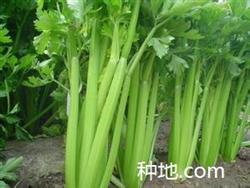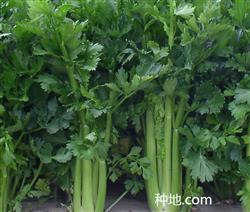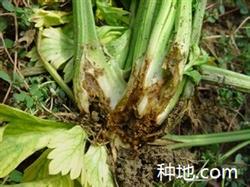How to pick celery seeds?

How to pick celery seeds? What do you need to pay attention to? Celery is a cold-tolerant vegetable, which needs a low temperature of less than 10 ℃ before flower bud differentiation and completes the vernalization process in about 10-15 days. However, it must grow to a certain size, about 3 to 4 leaves can feel the low temperature, and the longer the seedlings are at low temperature, the higher the bolting rate. Through vernalization of celery, it can blossom and bolt only under long sunshine. Therefore, sowing celery in early spring and bolting in the same year, summer and autumn celery can stay in the vegetative growth stage for a long time, continue to form new leaves, and can bolting and blossom in the next spring after low temperature in winter. Therefore, there are two seed collection methods of celery, one is old root seed collection, the other is small plant seed collection. 1. The method of old root seed collection in open field, autumn root storage in winter and seed collection in spring is called old root seed collection method. The advantage of this method is that the seed standard can be selected strictly, the seed can be selected and purified, and the seed yield is high. The disadvantage is that the seed storage is more labor-intensive, if the storage period is hot or frozen, the survival rate is low after planting. There are two ways to cultivate and collect ① old roots with celery old roots: one is to split celery twice and then extend the last harvest to around October 20; the other is to sow seeds in the evening of July to cultivate old roots. Either way, the celery should be rooted before and after Frosts Descent, and a robust plant with variety characteristics was selected as the seed plant. The selected plant had a petiole of 2 cm to 3 cm long, cut off the aboveground part, and plucked the beard root to dry for 2-3 days. Store it in the vegetable cellar at the end of October. The old roots of ② should be protected from freezing, injury and heat decay before and after storage. It can be stored in a cabbage cellar. If the quantity is large, it can also be stored in a separate cellar. Generally store more, but it is best to use straw tube (station) storage. Use straw to make a 150 cm high and 50 cm thick cylinder "station". Then, put the selected and sorted celery roots into the "station". A passage should be left between "station" and "station" to facilitate ventilation and reverse movement. The storage temperature is 2 ℃, above 0 ℃, it is easy to damage and rot, and if it is lower than-4 ℃, it will be frozen. The pits were poured every 3-5 days at the initial stage of storage, the cellar temperature was lower from December to February of the following year, every 10-15 days, and increased from March to before planting, every 4-5 days. The way to move upside down is for two people to mention the "station" on the spot, leak the celery root from the lower part, change the position of the "station", pick out the rotten old roots, and put the rest into the "station". The colonization and field management of old roots of ③ are generally planted in the first and middle of April, with row spacing of 56 cm and spacing of 43 cm, with 3 plants per tree. Applying low fertilizer 3000kg to 5000kg per mu, ridging before planting, pressing again with rollers, covering 1.5 cm of soil, pressing for 1 to 2 times after planting, ridge planting is better than border planting, easy to drain, and the disease is mild. It is necessary to shovel frequently after planting, and before the lower part of the plant branches to seal the ridge, cultivate the soil many times to preserve soil moisture and prevent lodging. Generally, bolting and budding occur in mid-late May, begin to blossom in the first and middle of June, and begin to blossom in the first and middle of June. Before budding, we should pay attention to "squatting seedlings", properly control moisture and prevent "crazy branching", so as to avoid delayed budding and flowering and affect seed yield. After flowering, fertilizer and water management should be strengthened, effective phosphate fertilizer and nitrogen fertilizer should be applied for 3 times, irrigation for 3 times, and coring should be carried out when most inflorescences bear seeds to make the seeds full. Rainy season should be timely drainage, timely medication, prevention and control of aphids, maggots and so on. Shelves should be inserted in late May to prevent lodging. ④ isolation should be paid attention to when collecting seeds among celery varieties. The original seed should be more than 1000 meters away from other celery varieties and carrots and other crops of the same family, and the seed production should be more than 500m away. ⑤ seeds were harvested in mid-late August and were harvested in time when most of the disk on the plant turned yellow. The flowering period of celery is long, the inflorescence is inconsistent after inflorescence, and the seed maturity on the same plant is very different. In order to ensure the seed quality, it should be harvested by stages. Generally, the harvest of seeds per mu is 75kg / mu, the weight of a thousand seeds is 0.4g, and the useful life is 1to 3 years. The old root has the advantages of pure seed character, full seed and high bud rate. When reproducing the original seed, the old root must be used to keep the seed. The open field can not overwintering area, but the cellar storage plant, overwintering later use. two。 Small plants are generally sown after August, small plants are harvested in winter and stored in sunny beds or vegetable cellars, and seeds are collected in the second spring frost period. The management technology is the same as the old root seed collection. Because there are no strict selection conditions for seed retention of small plants, successive use will lead to variety degradation, which can only be carried out alternately with seed collection of adult plants in order to maintain good seed character. 3. The main diseases and insect pests to control celery diseases are relatively mild, and there are two common diseases. One is spot disease, the other is root soft rot. Aphids are the main pests of celery. The main diseases control celery spot disease: also known as early blight, which mainly occurs on leaves from July to August, but it can also damage petioles when it is serious. Yellow-green water-immersed spots appeared on the leaves in the early stage, and gradually became light brown or even brown in the later stage, with yellow round spots on the edge. This kind of disease spot gradually enlarges and appears angular due to the limitation of leaf veins. the back of the disease spot grows gray-white powdery pathogen conidia, which are transmitted by air. The method of prevention and treatment is to spray the solution of bacilli 800x or 1000 times of cupric sulfate in the early stage of the disease. Celery root rot is often caused by stored old roots. The damaged area is in the form of water immersion, and the rot gives off a light gray sticky juice. When it occurs in the garden, a dark brown spindle-shaped spot appears on the petiole and stem attached to the ground, which gradually expands and becomes soft and rotten. Because soft rot bacteria remain in the soil, and in addition to celery, but also damage cabbage, radish and other root vegetables. Therefore, in order to avoid planting and collecting seeds in the garden where the disease occurs, it is necessary to carry out 2-3 years of crop rotation. For the stored old root, prevent injury when digging, and pick out the diseased old root in time. The main pest control of celery the main pest is aphid. Generally, the harm is serious from July to August, which can be prevented and treated with 1000 times liquid of 50% compound fruit. Autumn celery is damaged by cabbage night insect from August to September of a few years. Spray it with 80% dichlorvos 800 × 1000 times or 50% phoxim 1000 times. More celery planting techniques
- Prev

How to fertilize celery? based on what
How to fertilize celery? Fertilization according to what? To produce 1000 kg celery requires 2 kg pure nitrogen, 1 kg phosphorus pentoxide and 4 kg potassium chloride. Before planting, 5000 kg of high-quality farm manure and 40 kg of phosphate fertilizer were applied per mu. Celery plant height 10 cm when the first topdressing, mu topdressing nitrogen 7-10 kg, potassium fertilizer 1...
- Next

How to do celery sclerotinia disease?
What if Sclerotinia disease harms celery? Sclerotinia sclerotiorum of celery can harm leaves, petioles and stems. In general, the leaves are the first to suffer from the disease, showing dark stains and a dense white mildew layer on the surface when it is wet. Then spread downward to cause petiole and stem disease. The injured part is brown water stain, when the speed is high, it forms soft rot, and the surface grows white.
Related
- Where is it suitable to grow horseradish in China? it is expected to see the middle altitude horseradish in Alishan.
- How to prevent tomato virus disease reasonably? (Control methods included)
- Many people like to plant towel gourd on the balcony. What are the main points of this method and management?
- What crops can chili peppers be mixed with?
- Fertilization techniques and matters needing attention in Tomato
- What are the grafting techniques for peach seedlings in spring?
- Harm and control methods of root swelling disease of Chinese cabbage
- What are the pests of sweet potatoes? How to prevent and cure it?
- Symptoms, causes and Control methods of navel Rot in Tomato
- The cause of "Cucumber rotten bibcock" in Farmers' planting Cucumber and its Control Plan

